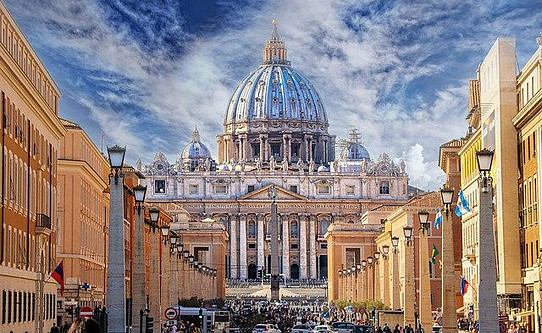
Hello there Rosary lovers! In this post we will be asking: is the Church visible?
There is a VERY common idea around today amongst many, many Christians that the Church of Jesus Christ is basically an invisible, spiritual church.
The idea is that it doesn’t really matter what denomination any of us belong to, because so long as we truly believe in Jesus, we are all united in a ‘spiritual’ body, which we can think of as ‘the church’.
I used to hold to this viewpoint, and I held to it very strongly. In fact, I saw nothing in Holy Scripture that offered any other viewpoint.
However, in 2017, I completely changed my mind on this issue. Let me explain why.
1. Water Baptism is Entrance into the Church
The Scriptures teach that water baptism is our entrance into Christ and into the Church.
‘As many of you as have been baptised into Christ have put on Christ,’ Galatians 3:27. We put on Jesus by being baptised. This is when we join his Church.
‘Those who received the word were baptised, and 3,000 souls were added that day,’ Acts 2:41. Added to what? To the Church, of course.
‘There is one Body and one Spirit … one Lord, one Faith, one Baptism,’ Ephesians 4:4-5. See here how Baptism is linked intrinsically to being in the ‘One Body’ of Christ, i.e., the Church.
‘For in one Spirit we were all baptised into one Body,’ 1 Corinthians 12:13. Through water baptism, the Holy Spirit brought us into the Body of Jesus Christ, the Church.
2. Water baptism is VERY physical
The issue here is that water baptism is not an invisible thing, or act. It is extremely VISIBLE and physical.
Now consider the logic here: we enter the Church of Jesus Christ through a very physical, tangible and visible act.
How can it be the case that we enter a purely spiritual church through a very physical event, such as baptism?
This makes no sense. If we enter the Church through a very physical and visible event, then it must be the case that the Church we enter is also VISIBLE and TANGIBLE.
3. The Body of Jesus Christ is Tangible
John the apostle writes in 1 John 1:1-2: ‘That which we have seen, that which we have heard and touched and our hands have handled of the Word of life.’
John is emphasising here the PHYSICAL expression of God made flesh. Jesus Christ came in the flesh. That is the big point of the letter of 1 John.
Jesus Christ’s flesh isn’t pretend, or ghostly, or fake or half-physical. Nope. Jesus Christ’s flesh is absolutely tangible and real and entirely physical: visible.
This is the wonderous truth of the incarnation of God the Word. It is a fundamental doctrine of Christianity. Lose this teaching and you lose Christianity. Without God becoming flesh – really becoming flesh – we are lost and there is no union of human beings with divinity.
Now consider the logic here. The phrase ‘the Body of Christ’ refers in Scripture not just to Jesus’ physical body, but also to the Church of Jesus.
Given that Jesus’ literal body is absolutely visible in the incarnation, we have to assume that the Church – Christ’s Body – also is very visible and tangible.
4. The Church has physical Leaders/Bishops on earth
In Hebrews 13, we are twice told that we must obey those who are over us in the Church.
In Titus 1 and the letters to Timothy, the apostle Paul calls upon Titus and Timothy to set things in order in the churches that they are watching over. Titus and Timothy were Bishops. Titus watched over all the churches of Crete and ordained priests there (Titus 1:5).
And Paul writes in Ephesians 4 that Christ has given the Church all sorts of leaders – apostles, prophets, teachers, etc. – to build up the Body, the Church.
None of this makes a lot of sense if the Church were only a spiritual community. Why do we have visible and tangible leaders who actually shepherd and rule us if the Church isn’t visible and tangible and physical?
5. The Church can command with authority
In Matthew 18:15-18, Jesus tells us about a situation where we have a brother who sins against us. We must go to them and tell them their sin and try to bring them to repentence.
But if the brother won’t listen to us – as is often the case, because of human pride and stubbornness – we have to bring the matter eventually to the Church.
Jesus then says: ‘If he will not listen to the Church, then treat him like a tax-collector or a Gentile.’ That is, he is excommunicated, he no longer has any fellowship with any church or with Me.
This is a massively important Scripture. It teaches that the Church of Jesus has the definitive authority to settle – with finality – disputes amongst Christians. When the Church speaks on an issue with authority, those she speaks to MUST listen and obey.
Failure to obey the Church’s decisions results in excommunication: being cast outside of Christ.
No, you can’t just hop down to the next church down the road and ‘all is aright’ with me and Jesus. It doesn’t work like that at all, according to Jesus.
This Church which speaks with authority must obviously be a Church which everyone can see and which everyone can hear. This is no invisible Church, but a very visible Church, with true power and authority from God to rule over Christians.
Only the Catholic Church fits this description. Check out this post on: what is the Catholic Church?
6. Christ prays for the unity of the Church as a testimony to the world
In John 17, Jesus prays a very precious prayer. In this prayer, Christ begs God the Father to make the Church one and unified, ‘that the world may know that you have sent me.’
Christ’s point is this: if my Church is seen to be united by the world, then the world will know that you, Father, have sent me. This will lead to the world becoming convinced of who I am and being converted.
One of the biggest issues non-Christians – and many Christians – have with all the churches of today is that they are not united. There are thousands of denominations, all claiming to be ‘faithful to Scripture’.
Frankly, it’s a laughingstock. No-one in the world sees any unity amongst Christians who believe in an ‘invisible church’.
If we aren’t united PHYSICALLY and truly in one physical Church, under the same leaders, we are NOT in union with each other. And the world will not know that Jesus has been sent by God.
Jesus Christ did not believe in an invisible church; he believed in a very visible Church that the world could clearly see.
As he says in Matthew 5:14: you (Christians) are ‘a City set on a hill … [which] cannot be hidden.’ Christians make up the Church, which is the City of God. It cannot be hidden because it isn’t invisible; it’s visible to the world.
7. All the Churches addressed in Scripture are visible Churches
Take any letter from Paul you like. They all start the same way.
‘To the Church at Ephesus.’
‘To the beloved Church at Rome.’
‘To the Church of the Thessalonians.’
And so on.
How about all the churches Jesus addresses in chapter 2-3 of Revelation?
Every single one of these churches is a physical, visible community governed by properly ordained leaders.
8. The Head of the Church is Visible

When Jesus was on earth, he was visibly present with his Church. He could be seen and touched.
Therefore, if the Head is visible, his Body is also visible.
Now, Jesus didn’t stay here, he went back to heaven. But he did leave someone in charge over the Church: St Peter.
In Matthew 16:16-18, Jesus clearly teaches that the apostle Peter was to be the earthly Head/Rock of the Church in Christ’s absence: ‘I say to you: You are Peter and on this Rock I will build my Church … And I give to YOU the keys of the kingdom of heaven, and whatever YOU shall bind on earth shall be bound in heaven,’ etc.
It’s clear as day that Jesus is speaking directly to Peter here, all of the ‘you’s are in the singular in the Greek.
Plus, Peter means Rock. He is also called Cephas in Scripture, which also means Rock.
So Peter stayed with the Church when Jesus ascended back to God. The Church still had a visible Head and Rock: Peter.
But Peter didn’t stay here. He was crucified upside down and died at Rome.
But Peter, like his Master before him, left a successor: Pope Linus.
So Pope Linus became the Head of the Church in Christ and Peter’s absence.
Linus was replaced by St Anacletus, who became Head of the Church in Christ, Peter and Linus’ absence.
And so on until the present day where we have Pope Francis, the current visible Head of Christ’s Church on earth.
If the Church has a Visible Head, then she must be Visible.
The opposite is also true. Many Christians believe that the Church is visible, but they deny that the Church on earth has a visible Head. This is a contradiction. How can the Body be visible without the Head also being visible?
It’s no good saying, ‘But we have Jesus in heaven,’ because to us he is invisible, he is not here anymore, he is risen and ascended. He left us visible Bishops and leaders in his place because the Church is visible and needs visible heads.
Likewise, the universal Church needs one visible Head on earth under Christ, and the only individual who could possibly qualify is the Pope of Rome.
If you’re interested in looking into this further, check out this article on the Papacy.
You may also wish to read about my conversion to the Catholic Church.
There is plenty more that could be said about this issue, but I trust I’ve offered enough to whet your appetite to know more.
If you have any questions or wish to get in touch, then email me or leave a comment.
God bless you, through Christ, the one Head of the Cosmic Church.